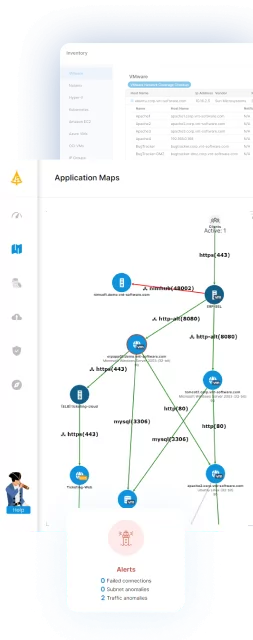Table of Contents
Toggle- What Is Cloud Security Architecture?
- Benefits of a Well-Defined Cloud Security Architecture
- Types of Cloud Security Architectures
- Key Components of a Robust Cloud Security Architecture
- Tips from the Expert
- Best Practices for Maintaining a Secure Cloud Architecture
- Cloud Visibility with Faddom: The Missing Piece of Cloud Security Architectures
What Is Cloud Security Architecture?
Cloud security architecture is a framework that outlines the security measures, technologies, and practices necessary to protect data, applications, and infrastructure within a cloud computing environment. It involves designing and implementing security strategies to mitigate risks and ensure the confidentiality, integrity, and availability of cloud resources.
Unlike traditional IT security models, cloud security architecture must address unique challenges such as shared responsibility, dynamic scaling, multi-tenancy, and hybrid or multi-cloud deployments.
Developing a secure cloud architecture involves understanding cloud-native risks and how cloud providers allocate security responsibilities. Architects must account for identity management, secure network zoning, encryption at rest and in transit, and continuous monitoring for anomalies.
Key aspects of cloud security architecture include:
- Identity and access management (IAM): Controlling who has access to what resources and ensuring that access is granted based on the principle of least privilege.
- Data security: Implementing encryption, access controls, and data loss prevention (DLP) measures to protect sensitive information both at rest and in transit.
- Network security: Using firewalls, intrusion detection systems, and other network security controls to protect the cloud environment from unauthorized access and network-based attacks.
- Application security: Securing applications from vulnerabilities by implementing secure coding practices, regular vulnerability scanning, and appropriate security testing.
- Endpoint security: Protecting devices that access the cloud environment, including laptops, mobile devices, and IoT devices, through measures like endpoint detection and response (EDR) and multi-factor authentication (MFA).
- Compliance and governance: Ensuring that the cloud environment adheres to relevant regulations and industry standards, such as GDPR, HIPAA, or PCI DSS.
- Security monitoring and incident response: Continuously monitoring the cloud environment for suspicious activity and having a well-defined incident response plan to address security breaches effectively.
- Zero trust security: Implementing a security model that assumes no implicit trust and verifies every access request, regardless of its origin.
Benefits of a Well-Defined Cloud Security Architecture
A well-defined cloud security architecture offers numerous advantages that improve the security posture and operational efficiency of organizations. Below are some key benefits:
- Improved risk management: Helps identify, assess, and mitigate security risks in real time, reducing exposure to vulnerabilities and breaches.
- Regulatory compliance: Ensures adherence to industry regulations and standards (e.g., GDPR, HIPAA), with built-in controls and audit capabilities.
- Enhanced data protection: Through encryption, access controls, and secure design principles, it protects sensitive data from unauthorized access or breaches.
- Increased operational efficiency: Automated security protocols reduce manual efforts, simplifying security operations and improving response times.
- Scalability: Supports dynamic scaling, enabling the organization to expand or contract cloud resources without compromising security.
- Minimized downtime: Continuous monitoring and proactive security measures help detect potential threats early, minimizing service interruptions or downtime.
- Improved visibility and control: Enables comprehensive monitoring and visibility into cloud resources, ensuring better control over cloud security.
- Protection against insider threats: Role-based access controls and identity management help minimize risks from internal actors while ensuring secure user access.
- Cost efficiency: By reducing security incidents and simplifying management, organizations can lower the costs associated with security breaches and incident response.
Types of Cloud Security Architectures
Public Cloud Security Architecture
Public cloud security architecture focuses on securing resources in cloud environments managed by third-party providers, such as AWS, Azure, or Google Cloud. In a public cloud, security responsibilities are shared between the provider and the customer. The provider manages the security of the underlying infrastructure, while the customer is responsible for securing the applications, data, and access controls within their environment.
Key components include data encryption, identity and access management (IAM), and network security. Public cloud providers often offer built-in security tools for threat detection, monitoring, and compliance. However, organizations must still implement their own policies for secure resource provisioning, ensuring proper configuration, and protecting sensitive data. Security in a public cloud architecture also involves managing external threats.
Private Cloud Security Architecture
Private cloud security architecture is for organizations that maintain their own infrastructure or rely on a third-party provider to host a dedicated environment. Unlike public clouds, private clouds offer greater control over security measures, as the infrastructure is not shared with other customers. This setup is often chosen for organizations with strict compliance requirements or sensitive workloads.
In private cloud security, organizations are responsible for securing both the infrastructure and the workloads they deploy. Components include strong network segmentation, internal firewalls, encryption, and tightly controlled access to resources. Identity and access management (IAM) is crucial for ensuring that only authorized personnel can access critical systems.
Hybrid Cloud Security Architecture
Hybrid cloud security architecture integrates both private and public cloud environments, providing flexibility in workload management. This type of architecture requires security strategies that bridge the different security models used in public and private clouds. It must account for secure data and application transfer between the two environments, ensuring that sensitive information remains protected regardless of where it resides.
Key considerations for hybrid cloud security include data encryption, secure APIs, and the management of identity and access controls across both clouds. The architecture needs to provide seamless visibility into resources across both environments, ensuring consistent monitoring and compliance. Organizations must also implement policies to handle the movement of data between on-premises and public cloud systems securely.
Multi-Cloud Security Architecture
Multi-cloud security architecture involves the use of multiple public cloud services to meet business needs, typically leveraging different providers for different advantages in terms of cost, performance, or regulatory compliance. The security approach in a multi-cloud environment requires managing and securing resources across different platforms, which can introduce complexity in terms of integration and consistent policy enforcement.
Effective multi-cloud security requires a unified strategy for access management, network security, and data protection. Organizations need to address the challenges of securing resources across different environments with varying security protocols and tools. Centralized security management tools, such as cloud security posture management (CSPM), help monitor and audit resources across multiple clouds.
Key Components of a Robust Cloud Security Architecture
1. Identity and Access Management (IAM) Strategies
Modern cloud architectures rely heavily on strong IAM practices, which ensure that only authenticated and authorized users can access cloud resources. IAM strategies enforce least privilege principles, using multifactor authentication, granular permission sets, and just-in-time access provisioning to minimize the attack surface. Centralized identity providers and federated authentication support seamless user experiences while maintaining rigorous control.
Effective IAM goes beyond initial user authentication to encompass onboarding, role assignment, privilege management, and revocation. Automation in IAM workflows helps prevent human error, while regular reviews of access logs and privilege policies limit exposure from privilege creep or dormant accounts. When integrated with monitoring and alerting systems, organizations can respond swiftly to anomalies.
2. Data Encryption and Protection Techniques
Data encryption is a core component of cloud security architecture, essential for protecting sensitive information both at rest and in transit. Organizations use encryption algorithms, key management systems, and secure protocols such as TLS for data exchanges. End-to-end encryption mitigates risks from unauthorized access, even if data is intercepted or improperly accessed within a cloud provider’s infrastructure.
Beyond encryption, data protection strategies also involve data masking, tokenization, and strict access controls on storage resources. Automated classification ensures that sensitive data receives the highest level of protection, aligned with compliance requirements. Integration with data loss prevention (DLP) tools further reduces the risk of accidental data leakage.
3. Secure Network Architecture Design
A secure network architecture segments cloud resources using virtual private networks (VPNs), subnets, and micro-segmentation to isolate workloads and limit lateral movement by attackers. Firewalls, security groups, and network access control lists (ACLs) provide granular traffic filtering both inbound and outbound. Zero trust principles often guide network design, assuming no implicit trust between components.
Network security also includes secure routing, encrypted connections, and monitoring for anomalous activity. Implementing intrusion detection and prevention systems (IDS/IPS) in the cloud enables organizations to identify and respond to threats. Regular audits of network configurations, combined with automated compliance assessments, help maintain best practices and limit exposure to misconfiguration-based attacks.
4. Application Security in Cloud Environments
Applications in the cloud are exposed to expanded attack surfaces and require layered security controls throughout their lifecycle. Secure DevOps (DevSecOps) integrates security at every stage of application development, from code scanning and dependency management to vulnerability assessments and runtime protection. Automated tools identify insecure code or outdated components before deployment.
Once deployed, cloud applications rely on web application firewalls (WAFs), secure API gateways, and container security solutions to guard against exploitation. Regular patching, configuration hardening, and continuous vulnerability assessments minimize risks from evolving threats. Ensuring application security also involves strict change management processes and resilience testing to prepare for incident response.
5. Endpoint Security
Endpoints, including user devices and virtual machines, are often targeted as initial entry points in cyberattacks. Cloud endpoint security requires agents or cloud-native controls that enforce device compliance, manage patches, and detect signs of compromise. Endpoint detection and response (EDR) platforms support rapid identification and remediation of malicious activity.
Endpoint security solutions also provide device control, application whitelisting, and secure configuration baselines. Integrating endpoint security with cloud access policies ensures that only trusted devices can connect to sensitive environments. Regular security awareness training reinforces endpoint hygiene and encourages users to recognize and avoid phishing or social engineering threats.
6. Compliance and Governance
Compliance and governance in cloud security architecture involve aligning controls with regulatory obligations such as GDPR, HIPAA, or PCI DSS. Using cloud provider compliance tools and third-party frameworks enables organizations to map technical controls to required standards. Automated evidence collection and reporting simplify audit preparation and ongoing compliance management.
Governance structures define how security policies are established, enforced, and updated across cloud environments. Implementing policy-as-code ensures consistent application of rules, with centralized visibility into violations or drifts. Effective governance also includes clear delineation of responsibilities between internal teams and cloud providers to avoid gaps in security posture.
7. Security Monitoring and Incident Response
Continuous security monitoring provides visibility into cloud activities, enabling real-time detection of suspicious behavior. Tools such as security information and event management (SIEM) and cloud security posture management (CSPM) aggregate logs, alert on anomalies, and provide actionable insights. Integration with threat intelligence feeds improves detection of emerging threats targeting cloud environments.
Incident response planning ensures that teams can act rapidly when threats are detected. An effective playbook includes containment and eradication steps, communication protocols, and post-incident reviews. Automation in incident response, such as automated ticketing and remediation workflows, helps reduce response time and limits the spread of malicious activity within the cloud infrastructure.
8. Zero Trust Security
Zero trust is an architectural principle where no user, device, or workload is implicitly trusted, regardless of location. It requires strict verification and continuous assessment of trust whenever resources are accessed. Network micro-segmentation, adaptive authentication, and context-based access policies are all common zero trust implementations in cloud environments.
Integrating zero trust with cloud-native services provides defense against lateral movement and insider threats. Organizations must also enforce encryption, continuous monitoring, and policy-driven controls across users, devices, and applications. Adopting zero trust requires a shift in mindset from perimeter-based defenses to comprehensive, context-aware security that continuously validates every request.
Related content: Read our guide to cloud workload security (coming soon)

Lanir specializes in founding new tech companies for Enterprise Software: Assemble and nurture a great team, Early stage funding to growth late stage, One design partner to hundreds of enterprise customers, MVP to Enterprise grade product, Low level kernel engineering to AI/ML and BigData, One advisory board to a long list of shareholders and board members of the worlds largest VCs
Tips from the Expert
In my experience, here are tips that can help you better adapt to the topic of cloud security architecture:
- Model threat scenarios by cloud service tier: Go beyond general threat modeling—map risks by SaaS, PaaS, and IaaS tiers. Each has different threat vectors (e.g., supply chain risks in SaaS, configuration drift in IaaS) and requires tailored mitigations.
- Deploy policy-as-code with drift detection: Use tools like Open Policy Agent (OPA) or HashiCorp Sentinel to codify security rules. Pair this with drift detection to alert when deployed resources deviate from the intended security baseline.
- Build a cloud-specific blast radius containment strategy: Assume compromise and architect the cloud with security boundaries (e.g., separate accounts/projects for environments, minimal inter-dependencies) to limit the scope of breaches.
- Incorporate behavioral baselining for cloud identities: Use machine learning to create behavioral profiles for cloud identities. Alert when behavior deviates (e.g., a developer suddenly accessing high-sensitivity data).
- Secure orchestration pipelines as first-class assets: CI/CD pipelines are often the most privileged cloud entities. Secure them with hardened runners, isolated build environments, and signed artifacts.
Best Practices for Maintaining a Secure Cloud Architecture
Organizations can protect their cloud environments by implementing best practices to establish and maintain a security architecture.
1. Regular Security Audits and Penetration Testing
Scheduled security audits are critical for identifying misconfigurations, vulnerabilities, and policy deficiencies in cloud infrastructure. These assessments leverage automated tools and manual inspections to provide a comprehensive view of potential risks. By conducting regular audits, organizations ensure configurations align with security best practices and compliance mandates.
Penetration testing simulates real-world attack scenarios to evaluate incident response, control efficacy, and potential breach paths. Regularly engaging with security professionals for external reviews uncovers blind spots and keeps internal teams vigilant. Both audits and penetration testing should be documented, with findings fed into continuous improvement cycles.
2. Automated Compliance Management
Automated compliance management leverages tools that map cloud resources against regulatory requirements and organizational policies. These solutions provide real-time compliance checks, generate audit-ready reports, and alert on policy violations as soon as they occur. This approach minimizes manual overhead and reduces the risk of noncompliance due to oversight or human error.
Incorporating compliance management into DevOps pipelines ensures that infrastructure-as-code and cloud deployments are evaluated before changes go live. Automated evidence collection and centralized dashboards also simplify reporting to auditors and stakeholders.
3. Continuous Security Training and Awareness
A critical but often overlooked component of cloud security is continuous education for users and administrators. Regular training keeps teams updated on evolving threats, new security features, and the unique risks present in cloud computing. Interactive courses, phishing simulations, and real-world scenario reviews reinforce secure behaviors and increase detection of social engineering attacks.
Empowering users with current knowledge helps eliminate unsafe practices around credential management, cloud access, and application deployment. Trainings should be adaptable and reflect changes in organizational policy or the threat landscape. Continuous security training strengthens the human element—often the weakest link—in a secure cloud architecture.
4. Disaster Recovery and Business Continuity Planning
Disaster recovery and business continuity planning are essential to mitigate the impact of outages, ransomware, or catastrophic events on cloud operations. Effective plans define backup schedules, recovery point objectives (RPO), and recovery time objectives (RTO), tailored to the criticality of each workload. Regular testing and updates ensure that recovery strategies remain feasible as infrastructure evolves.
Integrating cloud-native backup solutions and automated failover capabilities simplifies disaster recovery. Business continuity policies should address dependencies across providers, regions, and third-party integrations, ensuring that services remain available and data integrity is maintained in worst-case scenarios.
5. Leverage Automation Tools for Security Monitoring to Enhance Efficiency
Automation tools for security monitoring simplify continuous observation, detect anomalies, and reduce manual inspection workloads. Automated solutions collect and analyze logs, generate alerts for suspicious behavior, and often trigger predefined response actions. These tools help organizations maintain consistent and rapid threat detection as cloud environments scale.
Integrating automation with incident response processes ensures rapid containment and remediation, minimizing damage from attacks. Automated monitoring also supports regulatory compliance by ensuring required logs are retained and relevant alerts are escalated immediately. This allows security teams to focus on high-priority threats first.
Cloud Visibility with Faddom: The Missing Piece of Cloud Security Architectures
A strong cloud security architecture requires not only effective policies and controls but also continuous visibility into the interactions between applications, workloads, and data across hybrid and multi-cloud environments. Many organizations struggle in this area due to blind spots within their infrastructure, which hinder their ability to enforce zero trust principles, detect misconfigurations, or contain lateral movement.
Faddom addresses this challenge by offering real-time, agentless application dependency mapping. This technology automatically discovers and documents every connection across both cloud and on-premises systems.
With Faddom, IT teams gain the clarity necessary to secure complex environments, simplify audits, and ensure compliance by being aware of how systems interact with one another. The deployment process takes less than an hour, providing organizations with immediate insights to reduce risk, optimize security strategies, and confidently support their cloud transformations.
Book a demo today to see how Faddom can enhance your cloud security architecture!




